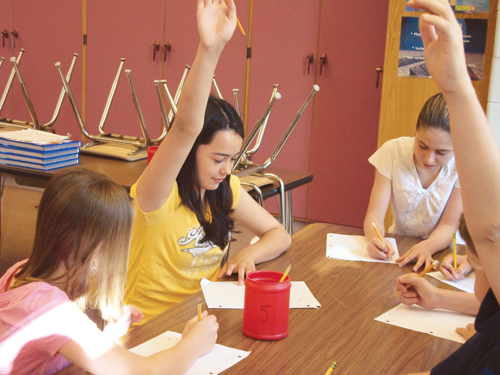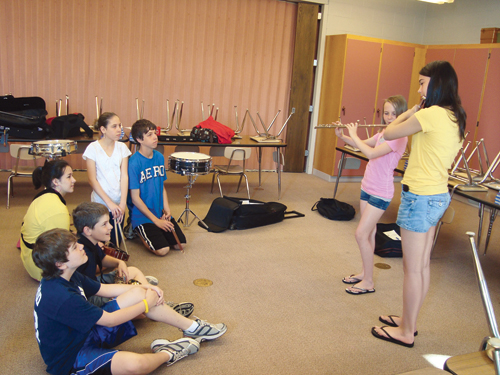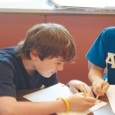
Students learn to write almost as soon as they learn to read. When they study art, they experiment with painting and sculpting. Music teachers, however, are often hesitant to teach composition. Although young students may be incapable of creating great masterpieces, the process of learning to compose is more important than the results. When students study composing, it trains their ears and improves note-reading skills because they learn to connect the notes on the page to the sounds they make on their instruments. For this reason composition should be part of lessons even for beginning students.
Students’ first attempts at composition usually show little understanding of music notation and conventions. They look more like an abstract wallpaper design than a musical composition. When asked to perform these compositions, students have little idea how they actually sound, resulting in a series of random notes. Teachers may not know how to guide these efforts.
Early Steps
Even very young children can recognize whether simple musical choices make sense. With beginners we start by playing “Mary Had a Little Lamb” and end on a pitch other than the tonic; the children immediately recognize that it sounds wrong. At first we may overblow and create nasty sounds to make them laugh, but after a few funny endings we play wrong notes with a good tone so they hear it as musically wrong instead of merely funny. Then we sing the tune but stop before the last note and ask them to sing the note for “snow.” Most find the correct pitch. The exercise is repeated and students are asked to end with something that does not fit. This type of exercise is the first step to teaching how composers make logical choices.
Beginners do not have the highly developed inner hearing of accomplished musicians, so they should write music only with sounds they can make on their instruments. To hear the sounds as they compose, they should sing or play each pitch. As students mature, they can begin to use sounds that they cannot play, but it seems that restricting them to two or three notes early on assures that they think about the flow of the melody carefully. The leap from composing with only sounds students can produce to more difficult music should be accompanied by other guides to prevent the pieces from lapsing back into random sound.
Composition Lessons
We begin to teach composition more formally with second-year students during small group lessons that occur about three times a month. We introduce ear training and composition exercises for five minutes at the beginning or end of class, or as a break from playing in the middle. We start by playing a few phrases and ask students if they end correctly. Then students get three or four notes to start a two or four-measure phrase that I will finish. Students have only 30 seconds or so to write these short phrases. To complete these tunes, one option is to simply repeat their phrase and point out that many band pieces have similar short, repeated patterns. We also do the opposite, beginning a phrase with three pitches and asking students to finish it using the same pitches. It helps to play the phrase a few times or teach them to play it so it is solidly in their ears.
Use these techniques to develop listening skills as part of daily warmups and expand them by asking students to improvise melodies or responses to the director’s phrases. As the class becomes comfortable responding, make it more difficult and ask them to compose two measures for the teacher to answer. More advanced elements including repetition within a phrase, dynamics, range, mode, and articulation.
Note Progression
Compositional choices should sound consistent with a work’s style. For example, there are conventions that establish how a piece should end, and if a composer strays too far from these expectations, it will not sound right to listeners. To help students understand how to progress through a melody, have them compose in teams of two to four. After determining the key, meter, and other parameters, the first student writes down a note. The next student plays that note and chooses a note or rest to follow. Team members take turns until the melody sounds complete. The students hear the melody before writing the next note, so they can plan a coherent sequence instead of writing a random series of pitches.
One requirement for student compositions is that the whole band should be able to play what they write. This can be tricky because the best three or four players write pieces that most students cannot play. Large skips might make musical sense based on the emotion or idea the piece conveys, but they should be revised because young trumpet players cannot jump from C4 to D5. When this happens, We tell the student it is a good piece, but ask him to revise it so that everybody can play it. Because they are second-year students the clarinet parts stay below the break. It creates some odd voice leading, but that is better than attempting pieces not everyone can play.
Phrasing
Most students write logical phrase endings early on, and sharper students start to end phrases on the fourth or fifth to lead to a longer melody. When that happens, help them to continue so it ends on a tonic. The best students can write tunes that follow the standard harmonic rules but do not sound bland or predictable.
What comes in the middle of phrases often causes problems, but most intuitively write two- or four-measure phrases that end on the tonic. The most common mistake is that if we ask students to write a piece with four beats per measure, they tend to have too many or too few beats in some of them. This seems odd because so much beginning band music is in two or four.
When students are given pitches for a melody, they are allowed to compose alone or in groups, but most prefer groups. Later in the year they are required to work together because cooperation is so important to band and orchestra. One student acts as the leader and writes the first few notes of a melody and the others write ideas to extend that melody.

Creating Longer Projects
During the second or third year of band or orchestra, students should learn to write pieces inspired by places, events, or things. This often comes naturally because they hear so much incidental music in movies and television. They understand why a piece of music that sounds right for a car chase will not fit a scene of fishing on a pond. A class composition project organized around a story provides a framework in which shorter student compositions combine to create a larger work. We use a variation of the game Mad Libs to develop a musical program for the piece. This is a funny, often nonsensical story created by filling in blanks with a requested part of speech. The students come up with a list of people, places, things, and actions and vote to choose one word from each of these categories. For example, they may pick a pizza delivery man for the person, a garage for the place, a hammer for the thing, and a race for the event. Each small group chooses a word from the list, and the members each compose a short melody for it as a homework assignment. Once these pieces are finished, they vote for the one in their group that best fits the word. The teacher can guide students and help them notate the compositions but should not offer too many musical ideas.
If a group writes a piece that does not seem to describe the word they picked, we will give them an example of what we might do for that word. Usually they see why it fits better and decide to revise their piece. We try not to squelch creativity but explain that composers make choices and some make more sense than others. If the students insist that the piece fits with the word, then we use their work in the band piece. If they think a flute trill for two beats describes solid, that is their choice. One of the more advanced students writes the short pieces on staff paper and then enters all of the music into notation software.
When all of the pieces are finished, we connect them to make a longer piece for the band. The product is not the most musical, but we try to make it as coherent as possible. For example, if two groups of clarinet players write pieces for the word car, transpose both to the same key and try to fit them together. This year the band had eight or 10 different words, and there were 20 small groups, so three did the noun, one did the adjective, and four did the person. The director can write percussion parts to go with most of the wind pieces and occasionally light woodwind and brass accompaniment for the percussion compositions if it seems to fit. It is not Mozart or Beethoven, but it instills creativity.
While teachers may feel that there is barely enough time for basic musicianship skills, teaching composition has many benefits. Students develop a greater understanding of the structure of music and notation and train their ears to understand the connection between notes on the page and the sounds they produce on their instruments. Perhaps most importantly, teaching more than the basics of instrumental music develops the minds and imaginations of students.
* * * *
Notation
At first we write down the students’ compositions for them. Younger students should think about creating without becoming bogged down by notation. The limited amount of class time we have for composing also makes it more practical for me to write, since we can do it much more quickly than the students.
During the year at least a dozen students come to us with pieces they have written outside of class. They bring something scribbled in a form of notation they invented. When students show that initiative, we teach them staff notation. A good exercise is to give them staff paper with melodies to complete, and require neat notation. Tell students that other players should be able to read their writing.
A Simple Composition
Last year’s band chose the word hyper as the adjective for a story. A group of four clarinettists wrote a piece for hyper with clear articulations and dynamics as well as repetition to suggest that the hyperness increases in intensity.






